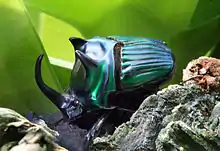Oxysternon
Oxysternon is a Neotropical genus of scarab beetles (Scarabaeidae) in the superfamily Scarabaeoidea. It can be distinguished from all other phanaeines and scarabaeine dung beetles by a long, spiniform extension of the anterior angle of the metasternum. Most species vary in color and pattern, and are more commonly found in tones of green, often infused with yellow or coppery highlights. All species appear very smooth or glassy smooth to the unaided eye.[1][2]
| Oxysternon | |
|---|---|
 | |
| male Oxysternon conspicillatum | |
| Scientific classification | |
| Domain: | Eukaryota |
| Kingdom: | Animalia |
| Phylum: | Arthropoda |
| Class: | Insecta |
| Order: | Coleoptera |
| Family: | Scarabaeidae |
| Tribe: | Phanaeini |
| Genus: | Oxysternon Laporte, 1840 |
| Type species | |
| Scarabaeus festivum[1] | |
| Synonyms | |
|
Sternaspis Hope, 1837 | |
Taxonomy
Nomenclature
The genus Sternaspis was proposed first by Hope in 1837, but the name was preoccupied and thus invalid. Laporte, writing under the pen name of Le Compte de Castelnau, proposed the genus Oxysternon to include several species of Phanaeus-like species. O. festivum was later designated as the type species.[3][1]
Phylogeny
The genus is monophyletic and its sister group is the genus Phanaeus. Two subgenera and two further species groups are recognized by some authors. It has been suggested that the current distribution of the species reflect vicariance events following climatic fluctuations in the Amazon.[1]
Species
There are currently 11 species in the genus Oxysternon.[2]
- Oxysternon conspicillatum Weber, 1801
- Oxysternon durantoni Arnaud, 1984
- Oxysternon ebeninum (Nevinson, 1890)
- Oxysternon festivum (Linnaeus, 1767)[4]
- Oxysternon lautum (Macleay, 1819)
- Oxysternon macleayi (Nevinson, 1892)
- Oxysternon palaemon Laporte, 1840
- Oxysternon pteroderum Nevinson, 1892
- Oxysternon silenus Laporte, 1840
- Oxysternon spiniferum Laporte, 1840
- Oxysternon striatopunctatum Olsoufieff, 1924
Distribution and habitat
Oxysternon is a Neotropical genus and most species are native to the Amazon basin or the Guiana Shield in South America. The ranges of the widespread O. conspicillatum and O. silenus also extend into the Chocó and southern Central America. Only two species are absent from both the Amazon basin and the Guiana Shield: O. pteroderum is restricted to Atlantic Forest in eastern Brazil and the common O. palaemon is found widely in the Cerrado.[1][2] Except for O. palaemon from the Cerrado, Oxysternon species inhabit very humid to mesic forest, sometimes extending slightly into nearby drier woodlands and savanna, and they have different degrees of tolerance to fragmentation and forest degradation.[1][2][5]
Behavior
The behavior of Oxysternon species has not been studied in detail. All species seem to be coprophagous or copro-necrophagous, although fruit pulp is sometimes used as an adult food resource.[6]
References
- Edmonds, W. D. (1972). "Comparative skeletal morphology, systematics and evolution of the phanaeine dung beetles (Coleoptera: Scarabaeidae)". University of Kansas Science Bulletin. 49 (11): 731–874. Retrieved 17 June 2016.
- Edmonds, W.D.; Zidek, J. (2004). "Revision of the Neotropical dung beetle genus Oxysternon (Scarabaeidae: Scarabaeinae: Phanaeini)". Folia Heyrovskyana. 11: 1–58.
- Castelnau, M. (Le Comte de) (1850). Histoire naturelle des insectes, coléoptères. Paris, France: Société Bibliophile. pp. Tome deuxieme, Premiere partie. doi:10.5962/bhl.title.36538., pag. 82
- Linné, Carl von (1767). Systema naturae : per regna tria natura, secundum classes, ordines, genera, species, cum characteribus, differentiis, synonymis, locis (Ed. 12, reformata. ed.). Holmiae :Impensis direct. Laurentii Salvii. doi:10.5962/bhl.title.68927. pag. 552
- Ferrer-Paris, José R.; Lozano, Cecilia; Cardozo-Urdaneta, Arlene; Thomas Cabianca, Arianna (2016). "Indicative response of Oxysternon festivum Linné (Coleoptera: Scarabaidae) to vegetation condition in the basin of the Orinoco river, Venezuela". Journal of Insect Conservation. 20 (3): 527–538. doi:10.1007/s10841-016-9886-6.
- Silvius, KM; Fragoso, JMV (2002). "Pulp handling by vertebrate seed dispersers increases palm seed predation by bruchid beetles in the northern Amazon". Journal of Ecology. 90 (6): 1024–1032. doi:10.1046/j.1365-2745.2002.00728.x.